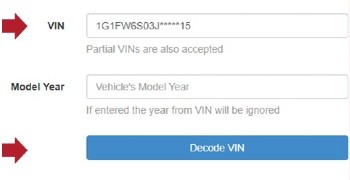Understanding a vehicle’s history is crucial, whether you’re buying a used car, ensuring your current vehicle’s safety, or simply curious about its origins. A Vin Code Checker is an invaluable tool that provides a wealth of information hidden within the 17-character Vehicle Identification Number (VIN). As automotive repair experts at obd-de.com, we’ll guide you through using a VIN code checker and reveal how it can unlock essential vehicle details.
What is a VIN Code Checker and Why is it Important?
Every vehicle manufactured for road use is assigned a unique Vehicle Identification Number (VIN). This number isn’t random; it’s a structured code that reveals key details about the car, including its manufacturer, model year, assembly plant, and more. A vin code checker, also known as a VIN decoder, is a tool that interprets this code, making complex vehicle information easily accessible.
Why is this important? A VIN code checker offers transparency and empowers you to make informed decisions. It can help you:
- Verify vehicle authenticity: Ensure the car is genuine and matches its documentation.
- Check vehicle specifications: Confirm the model year, engine type, and original equipment.
- Identify the manufacturing plant: Discover where your vehicle was assembled.
- Access safety recall information: Check for any outstanding safety recalls related to your vehicle.
- Research vehicle history: Some VIN decoders integrate with databases to provide accident history, title information, and more (often through paid services).
For reliable and official information, we recommend using the National Highway Traffic Safety Administration’s (NHTSA) free VIN decoder. NHTSA is a U.S. Department of Transportation agency dedicated to vehicle safety, making their VIN decoder a trustworthy resource.
Step-by-Step Guide: Using NHTSA’s Free VIN Code Checker
NHTSA’s VIN decoder is straightforward to use and provides essential vehicle manufacturing information, including the assembly plant. Here’s how to use it:
Step 1: Access the NHTSA VIN Decoder.
Navigate to the official NHTSA VIN decoder website: https://vpic.nhtsa.dot.gov/decoder/. This is the direct link to the free tool provided by the US government.
Step 2: Enter the VIN.
Locate the VIN on the vehicle. It’s typically found on the driver’s side dashboard (visible through the windshield), the driver’s side doorjamb, vehicle registration documents, and insurance cards. Enter the complete 17-character VIN into the text box on the NHTSA website and click “Decode VIN”.
Step 3: Interpret the Results.
The VIN decoder will process the information and display a detailed vehicle specification sheet. Scroll down to the bottom of the results page. You’ll find a field clearly labeled with the vehicle’s “Build Plant” and “Country of Manufacture.” This section reveals where your vehicle was assembled, providing interesting insight into its origin.
Unlock Vehicle Secrets Beyond the Manufacturing Plant
While NHTSA’s free VIN decoder is excellent for accessing manufacturing information, remember that VIN code checkers can reveal much more. Depending on the decoder and associated databases (some are subscription-based), you can potentially uncover:
- Vehicle Specifications: Detailed information on the engine, transmission, safety features, and original equipment.
- Sales History: Dates of sale and locations where the vehicle was sold.
- Accident History: Records of reported accidents and damage.
- Title History: Information on previous owners and title issues (like salvage or rebuilt titles).
- Recall Information: Crucial safety recall notices from manufacturers and regulatory bodies.
Conclusion:
A vin code checker is a powerful tool for anyone involved with vehicles. From verifying basic specifications to uncovering hidden history, understanding how to use a VIN decoder, especially resources like the NHTSA’s free tool, is an essential skill. Whether you are a car buyer, seller, or simply a vehicle owner, leverage the power of the VIN to gain a deeper understanding of your vehicle.
